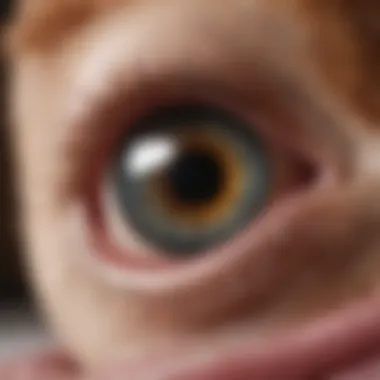Intestine Blockage Treatment: Options and Considerations


Intro
Intestinal blockages in pets can create urgent health issues that require immediate attention. Recognizing the signs of an obstruction and understanding treatment options is crucial for pet owners. This article provides a detailed exploration of the various ways to handle intestine blockages, emphasizing both conservative and surgical strategies, and highlights vital elements of post-treatment care. By understanding these concerns, pet owners can enhance their pets' welfare significantly.
Understanding Your Pet
Understanding your pet's background can provide useful context when dealing with health issues like intestinal blockage. Different breeds may exhibit varying levels of predisposition to gastrointestinal problems.
Breed Traits
Certain breeds may have unique dispositions towards intestinal blockages. For example, smaller breeds such as Chihuahuas and Toy Poodles may be more susceptible due to their size and eating habits. Larger breeds might develop obstructions due to overeating or swallowing non-edible items. Knowing these breed traits can help you stay alert for potential issues.
Common Temperaments
A pet's behavior can help you notice health changes. Pets that are usually playful but suddenly become lethargic may need immediate evaluation. Changes in appetite or interest in their surroundings can signal digestive issues, including blockages.
Special Needs
Some pets have special dietary requirements or digestive sensitivities. Awareness of these needs enables pet owners to make informed choices regarding food and supplement selection, thereby reducing the risk of blockages.
Pet Care Essentials
Good pet care lays the foundation for preventing health issues, including intestinal blockages. Here are some essential pet care guidelines.
Nutrition and Feeding Guidelines
Proper nutrition is key to a pet's overall health. Offering high-quality pet food with balanced nutrients promotes digestive wellness. Be aware of your pet's specific dietary needs and follow feeding guidelines provided by veterinarians. Regular feeding schedules can also prevent overeating, which may lead to blockages.
Grooming Tips and Techniques
Regular grooming helps you monitor your pet's health. While grooming, keep an eye out for any unusual behavior or physical issues that might require attention. Furthermore, brushing reduces shedding and matting, which can sometimes lead to ingested hairballs in pets like cats.
Health and Wellness
Routine veterinary check-ups are essential. These visits can help catch potential health issues early, including intestinal blockages. Vaccinations and parasite prevention are equally important in maintaining a pet’s overall health.
Training and Behavior
Proper training can mitigate some behavior issues that may lead to health concerns.
Basic Training Techniques
Basic commands like “leave it” can prevent pets from eating harmful objects around the home. Teaching commands also establishes a bond between the pet and owner, fostering mutual respect.
Behavioral Problems and Solutions
Observation is vital. If your pet shows behavior changes, it could indicate discomfort or health problems. Addressing behavioral matters can be essential in maintaining a healthy relationship and preventing health concerns.
Mental Stimulation Activities
Engaging your pet with toys, puzzles, or treats can keep them mentally active and deter them from destructive behaviors, including scavenging for inappropriate items.
Engaging with Your Pet
Engagement is an important aspect of your pet's health and happiness. Activities can strengthen your bond while keeping your pet physically and mentally stimulated.
Interactive Games and Toys
Investing in interactive toys can be beneficial. These toys keep pets occupied and can help prevent boredom, reducing the likelihood of them seeking out harmful objects to chew or swallow.
Safe Outdoor Activities


Regular, controlled outdoor time allows pets to explore their environment. Always supervise your pet during outdoor activities to prevent them from ingesting harmful substances.
Family-Friendly Pet Interactions
Involving family members in pet interactions can enhance your pet's socialization. However, educate everyone about safe pet handling to minimize risks associated with rough play.
Pet Adoption and Integration
Adopting a new pet is a rewarding experience, but preparing adequately is essential for a smooth transition.
Choosing the Right Pet for Your Lifestyle
Consider your lifestyle carefully before adopting. Some pets have specific needs that might not align with your daily routine.
Preparing Your Home for a New Pet
Create a safe space for your new pet. Remove items that can be hazardous and ensure that food and toys are appropriate for their age and size.
Tips for Smooth Prolusion
If you have other pets, gradual introductions are crucial. Allow your pets to get used to each other in controlled situations to avoid undue stress.
Proper care and timely intervention can dramatically improve outcomes for pets suffering from intestinal blockages. Always consult a veterinarian when in doubt.
Understanding Intestine Blockages
Intestinal blockages in pets are not uncommon and can have severe health implications. This understanding is critical for pet owners and caregivers. Being aware of how these blockages occur, their signs, and their types can prove invaluable in ensuring timely treatment. Recognizing these factors can help mitigate risks and determine appropriate next steps.
Definition and Causes
An intestinal blockage occurs when there is a physical obstruction within the gastrointestinal tract. This can happen due to various reasons, such as ingesting foreign objects or a buildup of undigested food. Other causes might include tumors, adhesions from previous surgeries, or even motility disorders affecting the intestines. Each cause can present unique challenges in diagnosis and treatment.
Signs and Symptoms
The signs of an intestinal blockage can manifest in several ways. Common symptoms include:
- Vomiting
- Loss of appetite
- Abdominal pain or distension
- Constipation or difficulty passing stools
- Lethargy
Pet owners should be vigilant. If they observe these symptoms, it is essential to consult a veterinarian promptly. Early diagnosis increases the chances of successful treatment.
Types of Intestinal Blockages
There are several types of intestinal blockages. Understanding these types is vital for effective treatment:
- Mechanical Obstruction: This is caused by a physical barrier, such as a foreign object.
- Functional Obstruction: Resulting from the intestines’ inability to move contents due to motility issues.
- Partial Blockage: Where some food can still pass through but may cause significant discomfort.
- Complete Blockage: This condition prevents all contents from passing through, often requiring urgent intervention.
Grasping these concepts allows pet owners to appreciate the complexities of intestinal health. Therefore, addressing these matters with a vet can enhance the overall well-being of their pets.
Diagnosis of Intestinal Blockages
Diagnosing intestinal blockages is a critical first step in addressing this health concern in pets. The diagnostic process helps identify the presence, location, and cause of the blockage. Early diagnosis can often prevent severe complications and improve prognosis. A comprehensive diagnostic approach ensures that the treatment plan is tailored to the specific needs of the pet.
Veterinary Examination
The initial phase in diagnosing intestinal blockages often starts with a veterinary examination. During this examination, the veterinarian will perform a thorough physical assessment. They may palpate the abdomen to detect any abnormal masses or signs of pain, which can indicate a blockage.
Additional elements in this examination may include evaluating the pet's history and existing symptoms. Such information is valuable in guiding subsequent diagnostic steps. For instance, understanding eating habits may provide clues about dietary causes behind the blockage.
Diagnostic Imaging Techniques
X-rays


X-rays are a common diagnostic tool in veterinary medicine for assessing intestinal blockages. They provide detailed images of the pet's internal structures and can reveal fluid levels, which is an indication of a blockage.
One key characteristic of X-rays is their speed; they can quickly give insights into the pet’s condition. For many, this can be a beneficial choice as it allows for a swift diagnostic process and the timely initiation of treatment. However, X-rays may not always reveal the precise cause of the blockage, limiting their effectiveness in some cases.
Ultrasound
Ultrasound is another significant diagnostic technique that provides a non-invasive method to examine soft tissue structures of the abdomen. It helps visualize the intestines and can show fluid pockets or foreign objects.
A major benefit of ultrasound is its real-time imaging capabilities, allowing veterinarians to assess movement and flow within the intestinal tract. It is often utilized when more detailed information is needed beyond what X-rays can provide. However, ultrasound requires trained personnel to perform and interpret the results accurately, which can be a limitation in some settings.
CT Scans
CT scans offer highly detailed cross-sectional images of the abdomen, allowing for an excellent view of the intestinal structures. This method is especially useful in complicated cases where the blockage might not be apparent through other imaging techniques.
The primary advantage of CT scans is their ability to provide comprehensive data about the area of concern. This high accuracy aids in making informed decisions regarding surgical intervention or other treatments. Nevertheless, CT scans are costlier and may not be available in all veterinary practices, which can restrict their use.
Laboratory Tests
Laboratory tests play an essential role in the diagnosis of intestinal blockages. Blood tests can reveal underlying issues, such as dehydration or infection, which are important in determining the urgency and type of treatment necessary. Further, they can help rule out other conditions that may present similar symptoms. It is important for pet owners to understand the range of diagnostic options available. Proper diagnosis safeguards the pet’s long-term health.
Treatment Options for Intestinal Blockages
Understanding the treatment options for intestinal blockages is essential for pet owners. Effective intervention can mitigate risks associated with these blockages and improve recovery outcomes. Each treatment type serves specific purposes, and knowing them can guide discussions with veterinary professionals.
Conservative Management
Fluid Therapy
Fluid therapy is critical in managing intestinal blockages. This approach aims to restore hydration and electrolytes in pets. It helps maintain circulatory stability, especially in cases of vomiting or diarrhea. A key characteristic of fluid therapy is its non-invasive nature, making it a first-line treatment.
The advantage of fluid therapy lies in its simplicity and effectiveness. It can often be administered in a veterinary clinic or even at home in some cases. However, its effectiveness is limited to less severe cases. If blockage persists, additional treatments may be necessary.
Dietary Adjustments
Dietary adjustments are vital for pets experiencing intestinal blockages. This method focuses on altering the pet's diet to facilitate easier digestion and passage of materials. The key characteristic is its preventive role. A suitable diet can reduce the risk of future blockages.
Unique features of dietary adjustments include the ability to customize food based on the pet's specific needs. While it's a beneficial approach, it requires careful selection of ingredients. Not all pets respond the same to dietary changes. Some may experience upset stomach or allergies, necessitating consultation with a veterinarian.
Surgical Interventions
Indications for Surgery
Indications for surgery refer to specific scenarios when surgical intervention becomes necessary. This is crucial when conservative management fails or if the blockage is due to a foreign object. The primary consideration is the immediate health risk to the pet. Surgery can be a lifesaver, providing a definitive solution to serious blockages.
The unique feature here is the rapid resolution of the issue, allowing pets to recover swiftly from acute distress. However, surgery carries risks such as infection or complications during recovery. Understanding when surgery is needed can be critical for pet owners during emergencies.
Surgical Techniques
Surgical techniques encompass various methods used to address intestinal blockages. Techniques vary based on the blockage's cause and location. A key characteristic is the precision involved in the procedure. Surgeons must assess the best technique for each individual case.
The techniques can range from non-invasive laparoscopic procedures to more traditional open surgery. Each method has its advantages and disadvantages. Laparoscopic surgery typically has shorter recovery times, but not all blockages can be addressed this way. Owner awareness of these options can aid in informed decision-making.
Postoperative Care
Monitoring Recovery
Monitoring recovery after surgery is essential. This process ensures that pets are healing appropriately and highlights any potential complications early. A key characteristic is attentiveness to the pet's behavior and physical condition. Checking vital signs and observing eating habits are fundamental.
Early detection of issues can lead to quicker resolution of complications. While monitoring can be done at home, veterinary follow-ups are also recommended. Owners should be prepared to seek help if their pet shows signs of distress, as time can be critical.
Nutritional Considerations


Nutritional considerations after treatment are equally important. The right diet can aid in recovery and restore a pet’s strength. A key characteristic is that dietary changes may be necessary following surgery. Pets might require a special diet to avoid further gastrointestinal stress.
The unique feature of proper nutrition is its role in preventing future blockages. A well-balanced diet can help maintain digestive health. However, transitioning to a new diet must be done gradually to avoid gastrointestinal upset. Owners should consult veterinarians to determine the best nutritional approach post-surgery.
Understanding treatment options empowers pet owners to make informed choices about their pets' health. By recognizing the appropriate steps, owners can help minimize the risks associated with intestinal blockages.
Potential Complications
Understanding the potential complications that may arise from intestine blockages is crucial for pet owners. Recognizing these potential outcomes can help in making informed decisions during treatment and care. Complications can vary from short-term risks, which may affect recovery, to long-term implications that could impact overall health. Addressing these concerns helps ensure better outcomes and provides peace of mind.
Short-term Risks
Short-term risks related to intestine blockages often manifest shortly after diagnosis or treatment. These risks include:
- Infection: Surgical interventions, in particular, can introduce bacteria into the body which may lead to infection. Monitoring for signs such as fever or unusual swelling is critical.
- Anesthesia Reactions: Pets may react differently to anesthetic agents. Some may experience respiratory problems or other unforeseen issues while recovering from sedation.
- Bowel Perforation: In severe cases, blockages can cause the bowel to perforate. This can lead to the spillage of intestinal contents into the abdominal cavity, resulting in peritonitis, a serious and often life-threatening condition requiring immediate attention.
Being aware of these risks allows pet owners to act swiftly if complications arise. Frequent checkups and close observation can help mitigate these issues and lead to effective management.
Long-term Implications
Long-term implications of intestine blockages can be significant, depending on the severity and treatment provided.
- Digestive Problems: Animals may face ongoing digestive issues such as chronic vomiting or diarrhea after treatment. These problems may require dietary changes or special supplements.
- Nutritional Deficiency: Extended blockages or surgeries can affect nutrient absorption. This may require a long-term dietary management plan to ensure pets receive adequate nutrition.
- Recurring Blockages: Pets that experience one blockage are at risk for future incidents. Understanding the underlying causes and modifying diet or lifestyle can help prevent recurrence.
It is essential to discuss any long-term concerns with a veterinarian. Regular follow-up visits help in monitoring the pet's health and detecting any potential issues early.
Preventive Measures
Preventive measures are crucial in mitigating the risk of intestinal blockages in pets. Understanding these strategies can aid pet owners in maintaining their animals' health and ensuring a better quality of life. Early intervention is key, and preventive practices can reduce the chances of blockages, which can lead to severe complications if ignored.
Dietary Management
Diet plays a significant role in preventing intestinal issues. Feeding your pet a balanced diet that meets their specific nutritional needs can make a difference. High-fiber diets can enhance digestive health. Fiber aids in the movement of food through the intestinal tract, reducing the risk of blockages.
Several considerations should be kept in mind when managing your pet's diet:
- Quality of Food: Opt for high-quality pet food, which is formulated with appropriate nutrients. This can help avoid ingredient-induced issues.
- Avoiding Table Scraps: Many human foods can lead to digestive disturbances. Certain items, like bones and fatty scraps, might contribute to blockages.
- Hydration: Ensure your pet has access to clean, fresh water at all times. Proper hydration helps maintain normal digestive function.
Exercise and Activity Levels
Regular exercise is fundamental for pets. Physical activity promotes healthy digestion and helps in weight management. Being overweight increases the risk of various health issues, including intestinal blockages.
Consider these aspects of your pet's activity levels:
- Routine Walks: Daily walks or playtime can stimulate digestion. Engaging activities not only prevent obesity but also enhance overall health.
- Stimulating Environment: Provide toys and challenges that require movement. These activities keep your pet engaged and active.
- Social Interaction: Pets often enjoy playing with others, be they animals or humans. Regular interaction can motivate them to remain physically active.
Regular Veterinary Check-ups
Routine veterinary visits are vital in preventative health care. These check-ups can help identify underlying health issues before they escalate into more severe problems.
Key points include:
- Early Detection: Regular check-ups provide opportunities to catch potential issues early. This can be critical in preventing intestinal blockages.
- Vaccinations and Parasite Control: Keeping vaccinations updated and controlling parasites through vet-recommended treatments reduces risks related to intestinal health.
- Tailored Recommendations: Your veterinarian can offer dietary and lifestyle suggestions specific to your pet's needs, helping in tailored management of their health.
Keeping your pet healthy is an ongoing commitment that requires attention to their diet, exercise, and regular health assessments. By implementing preventive measures, pet owners can significantly lower the risks associated with intestinal blockages, ensuring their loved ones thrive.
Ending
Understanding intestine blockage treatment is pivotal for pet owners. The risks associated with intestinal blockages are significant, making prompt intervention crucial. Knowing the various treatment options, ranging from conservative management to surgical interventions, empowers pet owners to make informed decisions about their pets’ health.
In this article, we have discussed important elements that contribute to effective management of intestinal blockages. For instance, the importance of early detection cannot be overstated. Recognizing signs and symptoms early allows for better outcomes. Furthermore, comprehending the different treatment modalities helps in identifying what is most suitable for a pet's specific situation.
Effective management hinges on understanding options.
Considering the potential complications that can arise is also essential. Pet owners who are well informed about both short- and long-term risks are better prepared to address any issues that may arise post-treatment. This knowledge also extends to preventive measures, helping owners implement strategies that minimize the risk of future occurrences.
Ultimately, managing intestinal blockages effectively involves collaboration with veterinary professionals, adherence to treatment protocols, and ongoing monitoring. By ensuring a proactive approach, pet owners can significantly enhance their pets' quality of life and longevity.
In summary, this article serves as a comprehensive resource, equipping pet owners with the knowledge required to navigate the complexities associated with intestinal blockages. The heart of effective management lies in understanding, preparation, and vigilant care.



